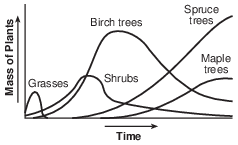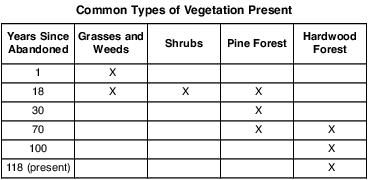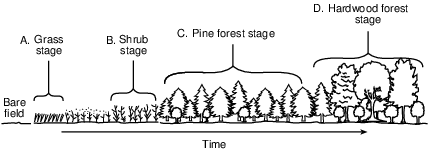Topic: Change Of Distribution Of Traits In A Population By Change Of Conditions
Change Of Distribution Of Traits In A Population By Change Of Conditions

The mass of plants shown in the graph refers to the mass of a number of
(1) populations
(2) decomposers
(3) ecosystems
(4) communities
Which statement best explains why different plant species are found at different water depths as represented in the diagram below?

(1) Energy flows through ecosystems in one direction, typically beginning with photo- synthetic organisms.
(2) In any particular environment, the growth and survival of organisms is affected by physical conditions.
(3) Plants on land are higher up the food chain than plants under water.
(4) Plant cells and some one-celled organisms contain chloroplasts.
A fundamental concept of ecology is that living organisms
(1) are independent and do not interact with each other or with the physical environment
(2) do not interact with other living organisms, but do interact with the physical environment
(3) interact with each other, but do not interact with the physical environment
(4) interact with other living organisms and interact with the physical environment
A graph is shown below.

The graph contains information about
(1) finite resources
(2) limiting factors
(3) biotic factors
(4) mineral availability
A student set up a small freshwater fish tank. The tank included water, fish, gravel, a snail, and plants, as represented below.

Which statement best describes an activity performed by a student investigating an abiotic factor using this setup?
(1) He records the temperature of the water.
(2) He feeds the fish 0.5 gram of fish food twice a day.
(3) He measures the growth of the plants with a metric ruler.
(4) He observes the snail scrape algae off the gravel.
Which statement describes an event that would most severely disrupt the process of ecological succession in an area?
(1) The season changes from spring into summer.
(2) Native plants are planted in an abandoned field.
(3) Plants and animals begin to colonize a newly formed volcanic island.
(4) A dam is built on a river to form a reservoir.
Which list contains only abiotic conditions that might be found in a pond ecosystem?
(1) temperature of the water, green plant populations, dissolved minerals in the water
(2) temperature of the water, dissolved oxygen in the water, dissolved minerals in the water
(3) bacteria, dissolved minerals in the water, temperature of the water
(4) dissolved oxygen in the water, fish populations, insect populations

Which diagram, A or B, most accurately represents interactions between biotic and abiotic factors in a forest environment? Support your answer. [1]
Diagram: ________________________________
Allow 1 credit for A and for supporting the answer. Acceptable responses include, but are not
• limited to:
• — The diagram shows the Sun and living things.
• — There are both biotic and abiotic factors shown in diagram A.
• — Diagram A includes the Sun and raw materials.
• — There are no abiotic factors in food web B.
• — Diagram B does not show the original source of energy.
• — Diagram B is missing an energy source and raw materials from the soil.
Found: A Plant-Eating Spider
Spiders are meat-eaters. Until recently, scientists thought that was true for the roughly 40,000 spider species in the world. Now, researchers have discovered a spider that eats mostly plants.
Bagheera kiplingi, a jumping spider, lives in Central America and Mexico. It nests in the leaves of acacia shrubs. Scientists have long known that ants live in these plants. The ants eat the plants’ little yellow vegetables. But scientists had no idea that the spiders eat the vegetables too.
Christopher Meehan was a college student when he found the plant nibbling spiders. “I thought I was hallucinating,” he told TFK (Time for Kids). “But by the end of the day, I had seen about 100 more spiders eating plants.”
Source: Time for Kids World Report,
Edition 10/23/09 Vol. 15, #7 p.3
Identify one abiotic factor that most likely affects the size of the acacia shrub population. [1]
Allow 1 credit. Acceptable responses include, but are not limited to:
• — light
• — minerals/nutrients
• — water/rainfall
• — temperature
Hydrothermal Vent Communities
Scientists discovered a unique hydrothermal ecosystem on the sea floor at hot-water vents thousands of feet below the ocean surface. Organisms in these deep-sea regions have no access to sunlight, so they depend on the heat, methane, and high levels of sulfur-bearing minerals found in the heated fluids in which they live. Scientists were amazed to discover vent communities able to sustain vast amounts of life. The vent organisms depend on bacteria that can use the sulfur-bearing minerals to produce organic materials. These bacteria live on rock surfaces and as free-floating blobs. Some bacteria live within and provide nutrients for an unusual species of giant tubeworms that lacks a digestive system. Snails, shrimp, and clams are among the animals that feed directly on the bacteria. Crabs feed directly on other animals in the vent community.
Identify one abiotic factor that makes the hydrothermal vent ecosystem different from other ocean ecosystems. [1]
Allow 1 credit. Acceptable responses include, but are not limited to:
• — absence of light
• — sulfur-bearing minerals/methane
• — high temperatures/heat
• — The pressure is very high at deep ocean depths.
Corals are a group of organisms that live in shallow, warm areas of the world’s oceans. Coral reefs are composed of a hard material that is produced by these small coral animals, and is then colonized by photosynthetic organisms called Zooxanthellae. These plant-like organisms generate sugars that are used by their animal partners for food and are needed for the survival of the coral.
State one possible reason that coral reefs exist only in shallow waters. [1]
Allow 1 credit. Acceptable responses include, but are not limited to:
• — Sunlight is available for photosynthesis in shallow waters.
• — Light may not be available in deep waters.
• — Their food providers live in shallow water.
• — More food is available there.
• — Zooxanthellae are photosynthetic.
Daphnia (water fleas) are sensitive to many changes in pond ecosystems. For this reason they are often used in bioassays, tests in which organisms are exposed to various levels of a chemical to determine what levels are safe. The results of these tests determine whether or not the chemical being tested will affect other pond organisms.
An experiment was designed to determine the toxicity of different salt solutions on cultures of daphnia. Five fish tanks were each filled with the same amount of water containing different concentrations of salt. Ten daphnia were placed into each tank. After 48 hours, the number of daphnia that had survived and the number of daphnia that had died in each tank were recorded and the percent mortality was calculated. The results of the experiment are shown in the data table below.

Directions: Using the information in the data table, construct a line graph on the grid on the next page, following the directions below.
Which salt concentration is most likely closest to the concentration of salt found in the natural environment of this species of daphnia? Support your answer. [1]
Salt concentration:_______________________ g/L
Allow 1 credit for 2.5 g/L and supporting the answer. Acceptable responses include, but are not
• limited to:
• — No daphnia died at this concentration of salt.
• — The most daphnia lived.
The data table summarizes the changes that occurred to farmland in the years immediately following its abandonment. The land is located in a very stable ecosystem. It was abandoned after years of overuse and weathering, which resulted in the depletion of soil nutrients.

Which type of vegetation appears to have the lowest soil nutrient requirements? Support your answer with information from the data table. [1]
Lowest soil nutrient requirement vegetation: ___________________________________________________
Allow 1 credit for grasses or weeds or grasses and weeds and supporting the answer. Acceptable
• responses include, but are not limited to:
• — They are the first plants/vegetation to grow on the abandoned farmland.
• — They grow in soil depleted of nutrients.
Nature Will Have to Clean Up Hawaii Molasses Leak That Killed Thousands of Fish
A massive spill of thick molasses has turned Honolulu Harbor into a watery wasteland where thousands of fish have been suffocated – a disaster that officials say Mother Nature will have to clean up.
“There’s nothing alive there at all,” diver Roger White told NBC affiliate KHNL after making a seven-minute video of dead sea life blanketing the bottom of the harbor.…
…“Unlike with an oil spill, it’s a sugar product so it will dissipate on its own,” Matson spokesman Jeff Hull told NBC News on Thursday. “There’s not an active cleanup.”
“The molasses is not toxic but it’s heavier than water so it’s spreading around on the sea floor, displacing the oxygen-rich water down there, and the fish are suffocating,” said Keith Korsmeyer, a professor of biology at Hawaii Pacific University.
The die-off also could lure predators like sharks, barracuda and eels to the harbor and neighboring Keehi Lagoon, experts warned.…
…Korsmeyer said marine life would probably repopulate the harbor, after the low- oxygen water moves out, but that could take months or even years.…
Source: http://www.nbcnews.com/news/other/nature-will-have-clean-
hawaii-molasses-leak-killed-thousands-fish-f8C11137030
Explain how the molasses spill caused many of the animals to die off. [1]
Allow 1 credit. Acceptable responses include, but are not limited to:
• — The molasses displaced oxygen-rich water and the fish suffocated.
• — As fish died, the predators had less food available and died.
• — Molasses turned the harbor into a water wasteland where fish were suffocated.

Identify two abiotic factors that can determine which types of organisms can inhabit an ecosystem. [1]
Allow 1 credit for identifying two abiotic factors. Acceptable responses include, but are not limited to:
• — light intensity and temperature
• — soil composition and pH
• — water availability and light
